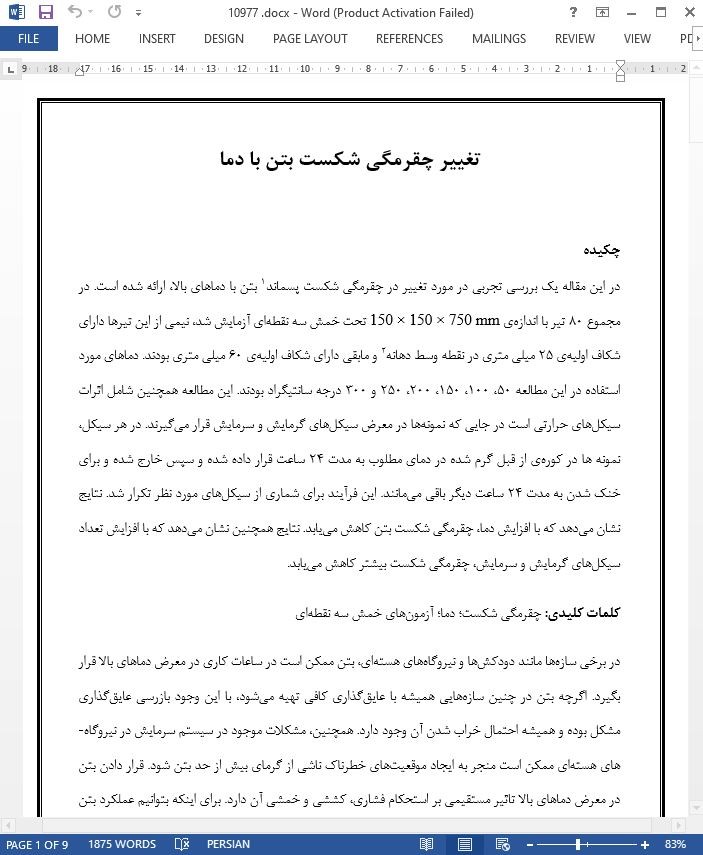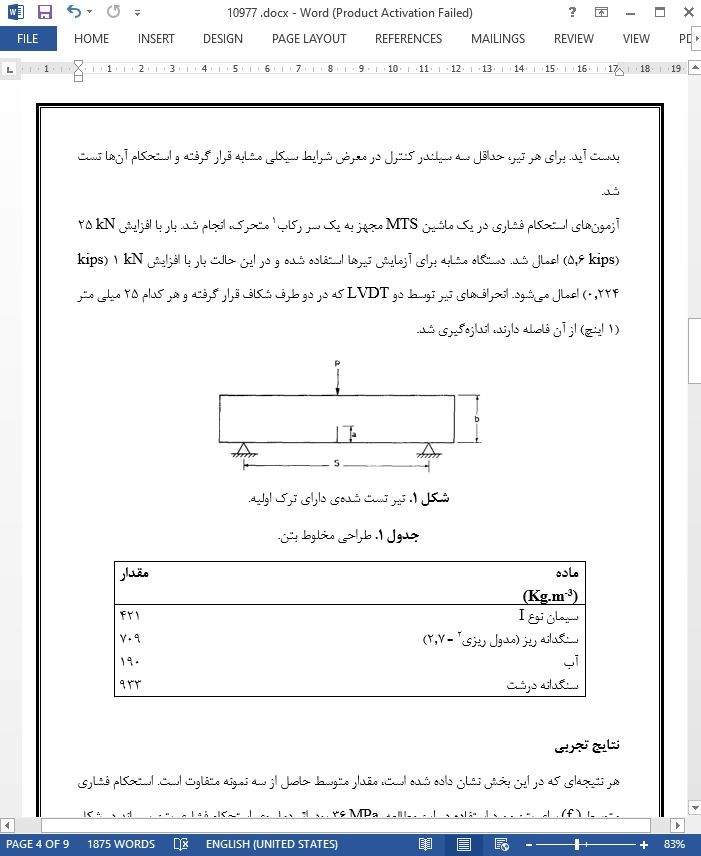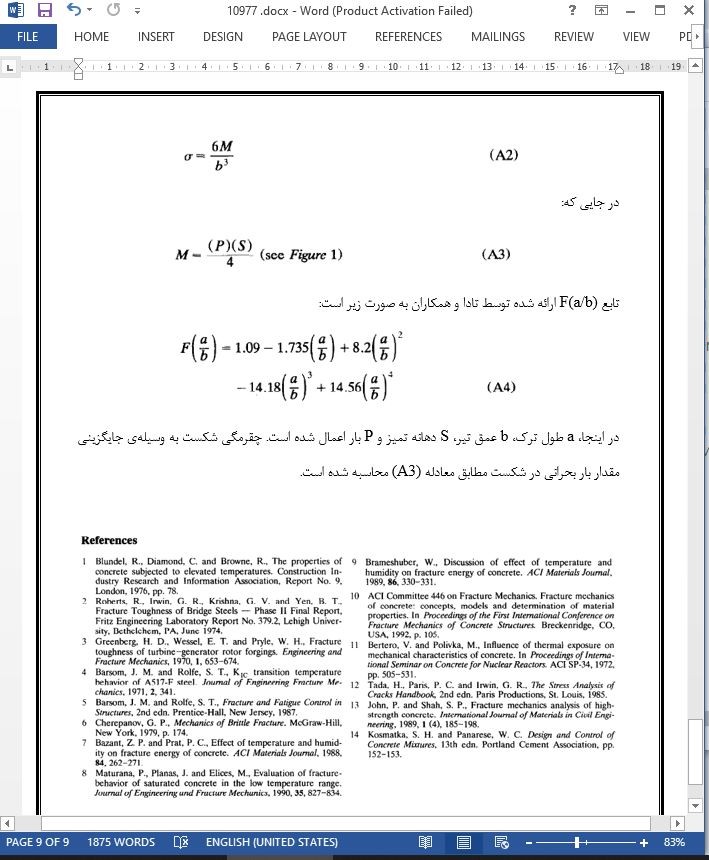
تغییر چقرمگی شکست بتن با دما
چکیده
در این مقاله یک بررسی تجربی در مورد تغییر در چقرمگی شکست پسماند بتن با دماهای بالا، ارائه شده است. در مجموع 80 تیر با اندازه ی 150 × 150 × 750 mm تحت خمش سه نقطه ای آزمایش شد، نیمی از این تیرها دارای شکاف اولیه ی 25 میلی متری در نقطه وسط دهانه و مابقی دارای شکاف اولیه ی 60 میلی متری بودند. دماهای مورد استفاده در این مطالعه 50، 100، 150، 200، 250 و 300 درجه سانتیگراد بودند. این مطالعه همچنین شامل اثرات سیکل های حرارتی است در جایی که نمونه ها در معرض سیکل های گرمایش و سرمایش قرار می گیرند. در هر سیکل، نمونه ها در کوره ی از قبل گرم شده در دمای مطلوب به مدت 24 ساعت قرار داده شده و سپس خارج شده و برای خنک شدن به مدت 24 ساعت دیگر باقی می مانند. این فرآیند برای شماری از سیکل-های مورد نظر تکرار شد. نتایج نشان می دهد که با افزایش دما، چقرمگی شکست بتن کاهش می یابد. نتایج همچنین نشان می دهد که با افزایش تعداد سیکل های گرمایش و سرمایش، چقرمگی شکست بیشتر کاهش می یابد.
در برخی سازه ها مانند دودکش ها و نیروگاه های هسته ای، بتن ممکن است در ساعات کاری در معرض دماهای بالا قرار بگیرد. اگرچه بتن در چنین سازه هایی همیشه با عایق گذاری کافی تهیه می شود، با این وجود بازرسی عایق-گذاری مشکل بوده و همیشه احتمال خراب شدن آن وجود دارد. همچنین، مشکلات موجود در سیستم سرمایش در نیروگاه های هسته ای ممکن است منجر به ایجاد موقعیت های خطرناک ناشی از گرمای بیش از حد بتن شود. قرار دادن بتن در معرض دماهای بالا تاثیر مستقیمی بر استحکام فشاری، کششی و خمشی آن دارد. برای اینکه بتوانیم عملکرد بتن را به طور کلی ارزیابی کنیم، همیشه تعیین چقرمگی شکست بتن (K1C) تحت شرایط کاری مهم است. تاکنون تحقیقات کمی برای مطالعه رفتار شکست بتن تحت دماهای بالا انجام شده است.
نتیجه گیری
1. چقرمگی شکست بتن به شدت تحت تاثیر دماست حتی پس از سرمایش. برای یک سیکل گرمایش و سرمایش، کاهش در چقرمگی شکست پسماند برای دماهای بیشتر از 50 درجه سانتیگراد قابل توجه تر می شود.
2. راه حل بسته استفاده شده برای محاسبه چقرمگی شکست بتن، مقادیر مختلفی برای نسبت های متفاوت (a:b) می دهد. این امر عمدتا ناشی از این حقیقت است که فشار انسداد ناشی از بهم پیوستن سنگدانه در ناحیه نوک ترک در راه حل بسته مورد استفاده، در نظر گرفته نشده است. این نکته مهم در حال حاضر توسط نویسندگان در دست بررسی است.
Abstract
This paper presents an experimental investigation on the variation of residual fracture toughness of concrete with elevated temperatures. A total of 80 beams 150 × 150 × 750 mm were tested under three-point bending, half of which had a 25-mm initial notch at mid-span and the rest of which had a 60-mm initial notch. The temperatures used in the study were 50, 100, 150, 200, 250 and 300 °C. The study also includes cyclic heating effects where the specimens were subjected to cycles of heating and cooling. In each cycle, the specimens were placed in a furnace preheated to the desired temperature for 24 h and then removed and left to cool for another 24 h. The process was repeated for the desired number of cycles. The results show that the residual fracture toughness of concrete decreases with the increase in temperature. The results also show that the fracture toughness is further reduced with the increase of number of heating and cooling cycles.
In some structures such as chimneys and nuclear power plants, the concrete may be exposed to high temperatures during operating hours. Although the concrete in such structures is always provided with adequate insulation, nevertheless, it is difficult to inspect the insulation and there is always a possibility of its deterioration. Also, problems with the cooling system in nuclear power plants may lead to hazardous situations were the concrete overheats. The exposure of concrete to elevated temperatures has a direct effect on its compressive, tensile and flexural strength’. In order to be able to assess the concrete performance in general, it is always important to determine its fracture toughness (K,c) under operating conditions. So far, little research has been done to study the fracture behavior of concrete under elevated temperatures.
Conclusions
1. The fracture toughness of concrete is greatly influenced by temperature even after cooling. For one cycle of heating and cooling the decrease in the residual fracture toughness becomes more significant for temperatures greater than 50°C.
2. The closed-form solution used for computing the fracture toughness for concrete gives different values for different ratios of (a:b). This is mainly due to the fact that the closing pressure due to the aggregate interlock at the crack tip zone is not taken into consideration in the used closed-form solution. This important point is currently under investigation by the authors.
بررسی تجربی
نتایج تجربی
نتیجه گیری
Experimental investigation
Experimental results
Conclusions
- اصل مقاله انگلیسی با فرمت ورد (word) با قابلیت ویرایش
- ترجمه فارسی مقاله با فرمت ورد (word) با قابلیت ویرایش، بدون آرم سایت ای ترجمه
- ترجمه فارسی مقاله با فرمت pdf، بدون آرم سایت ای ترجمه



